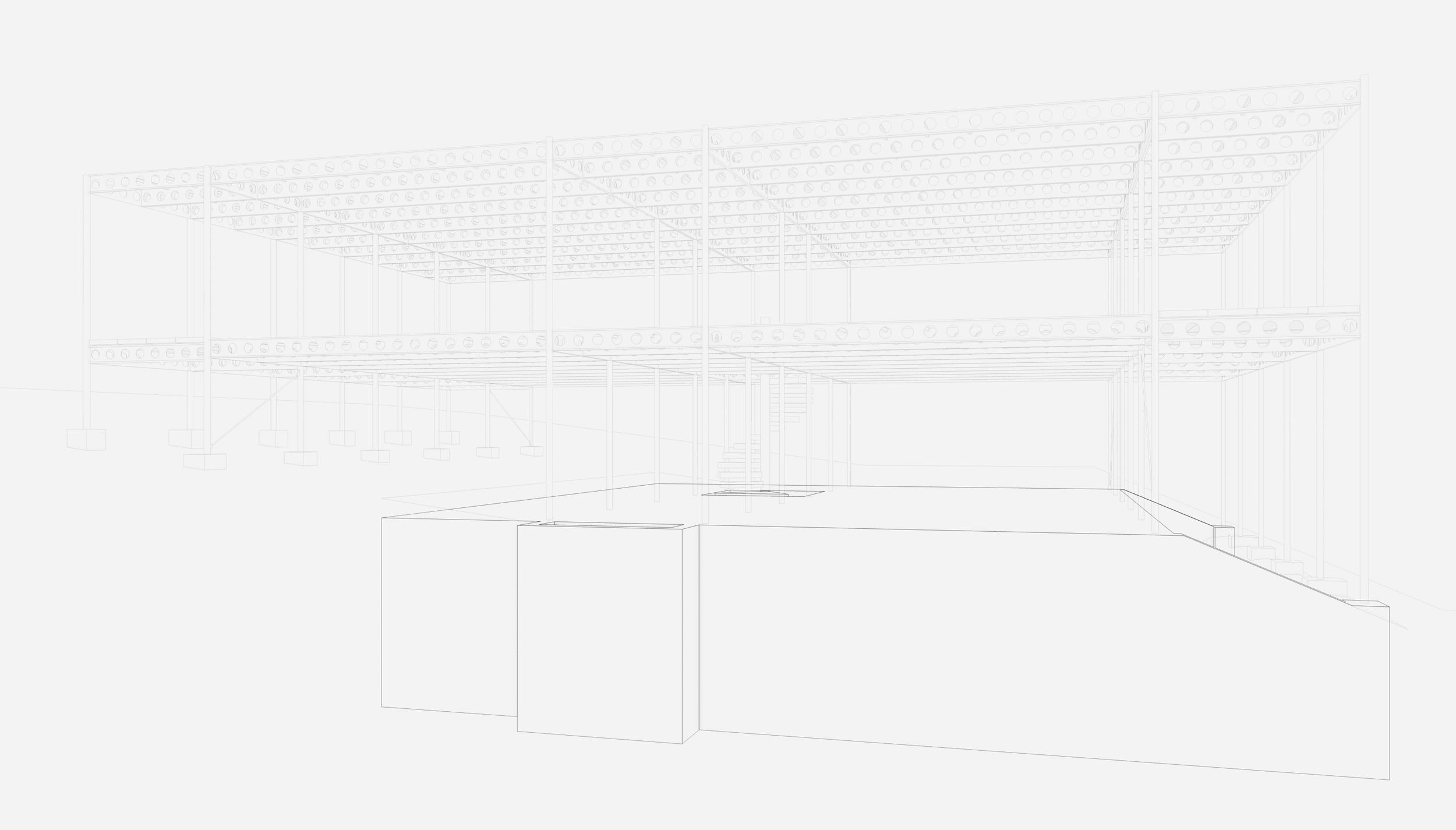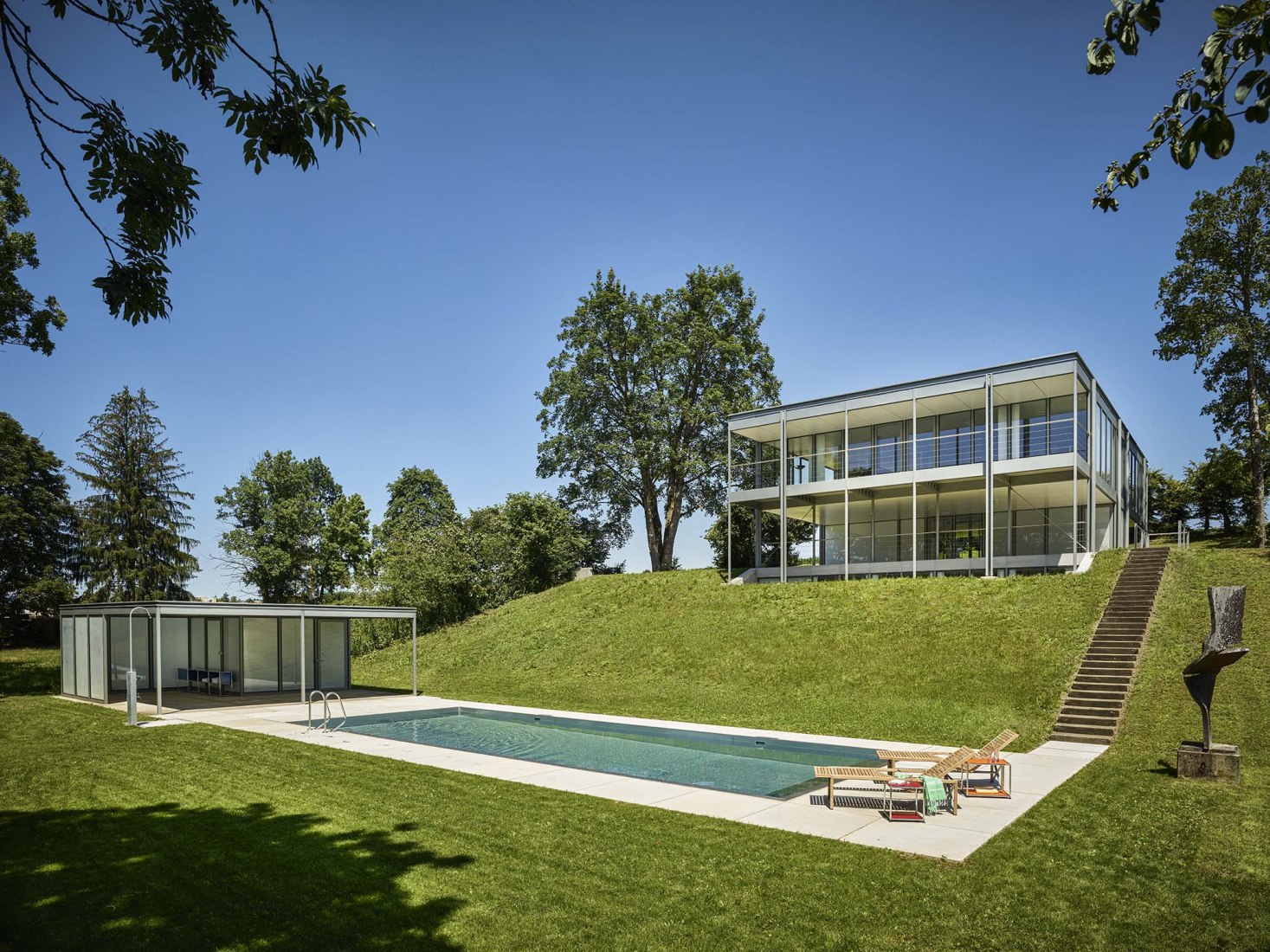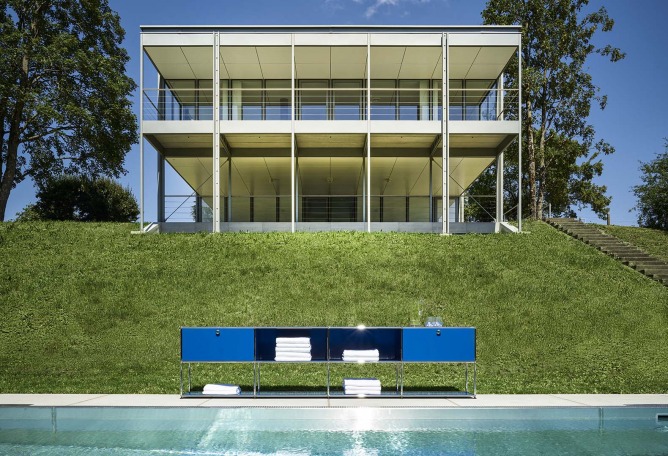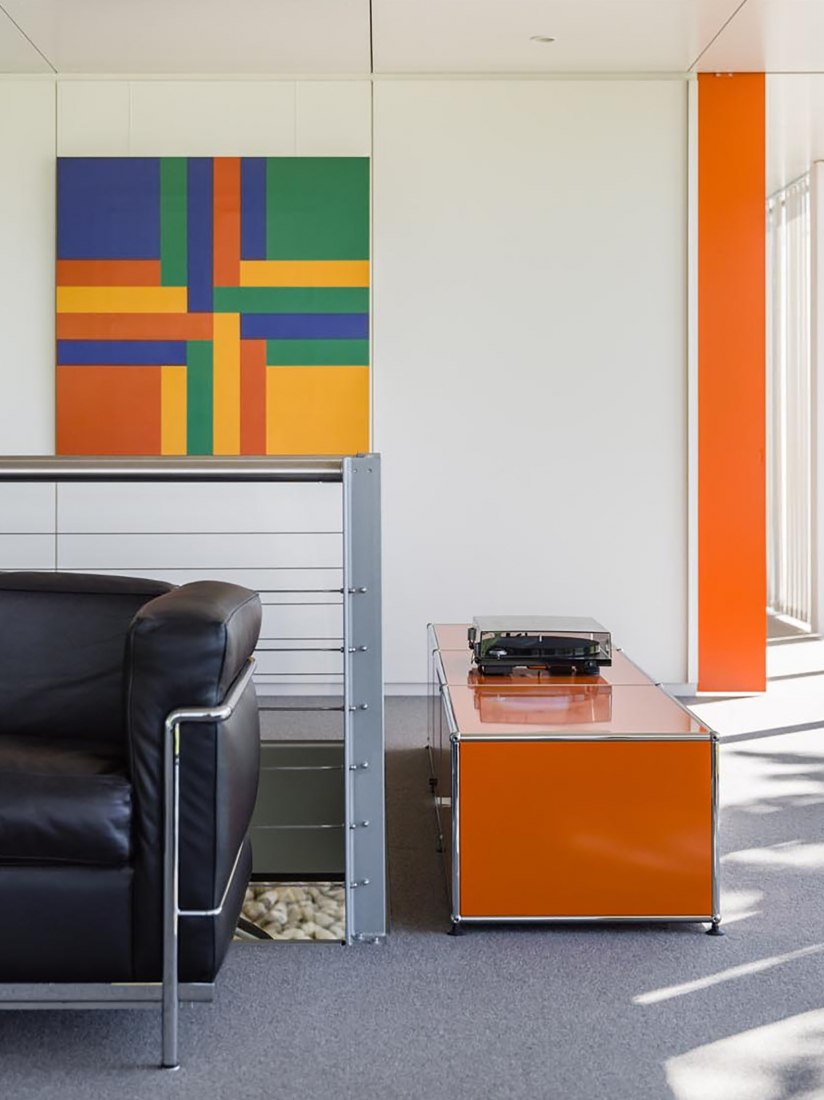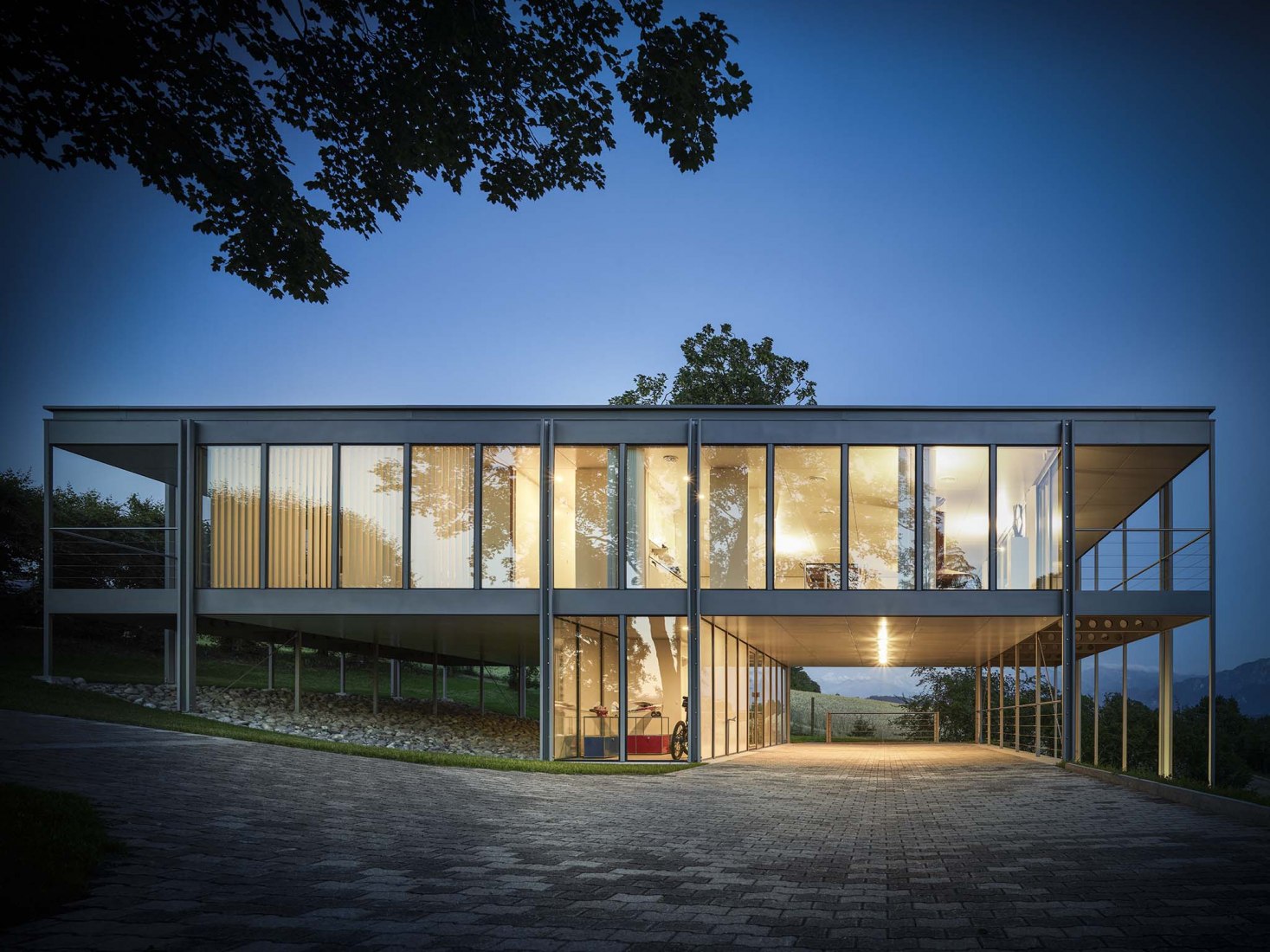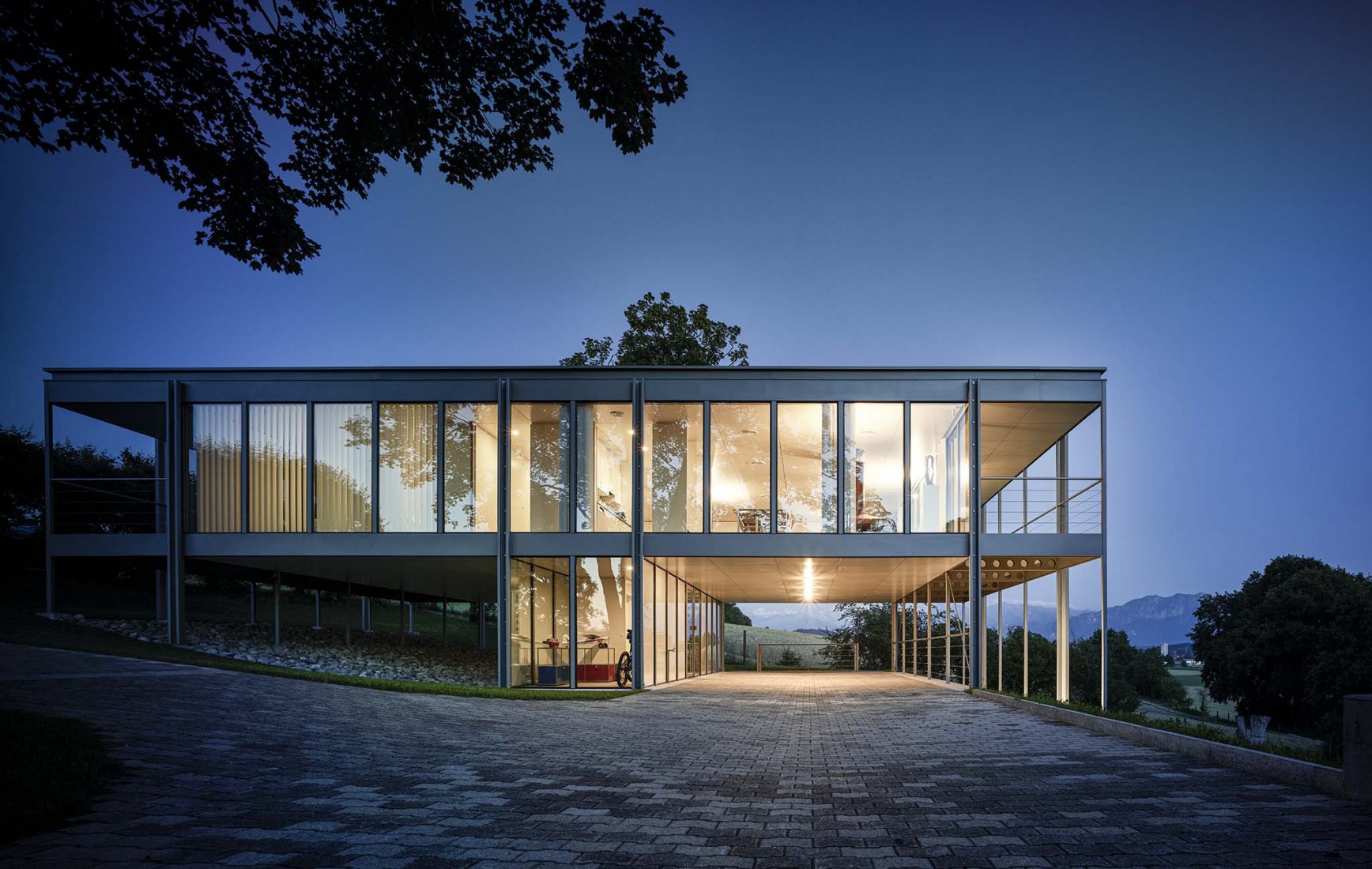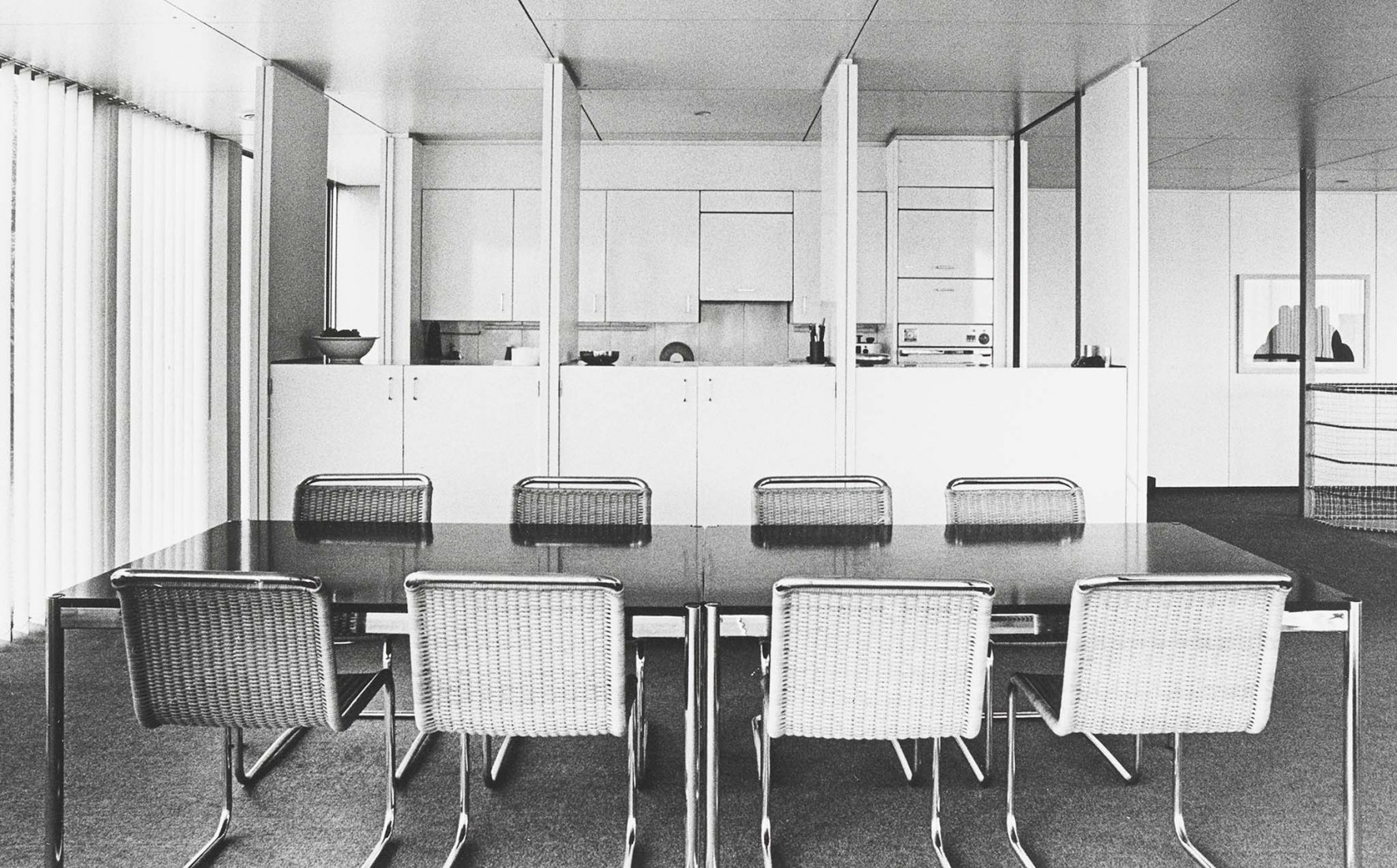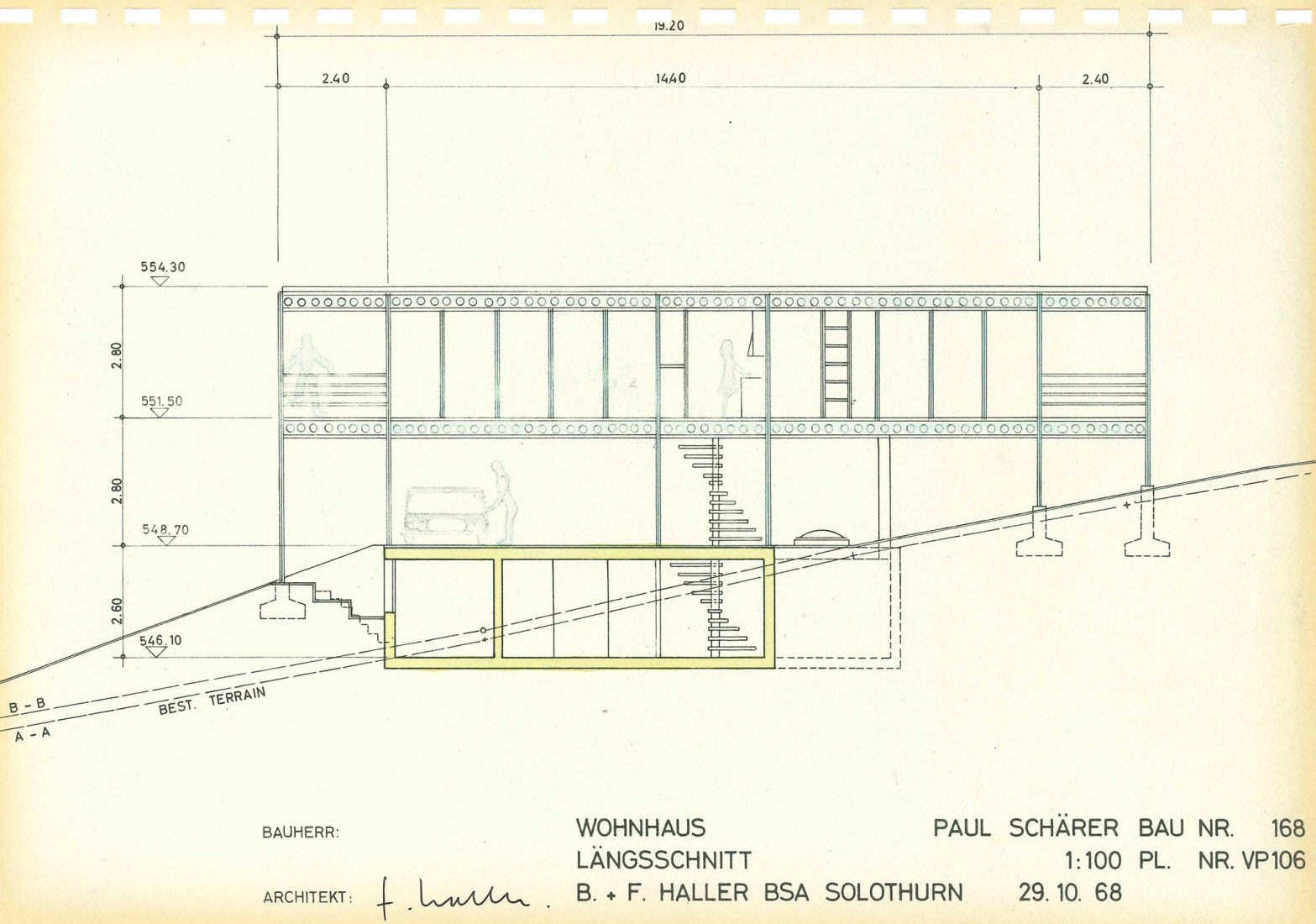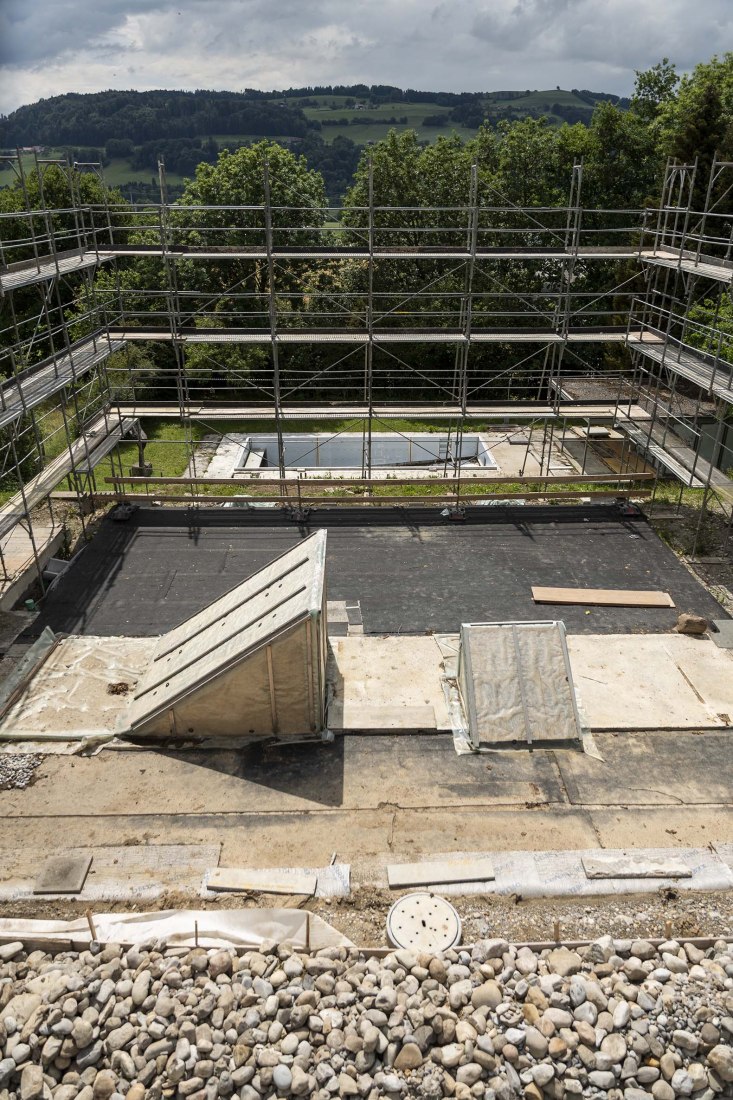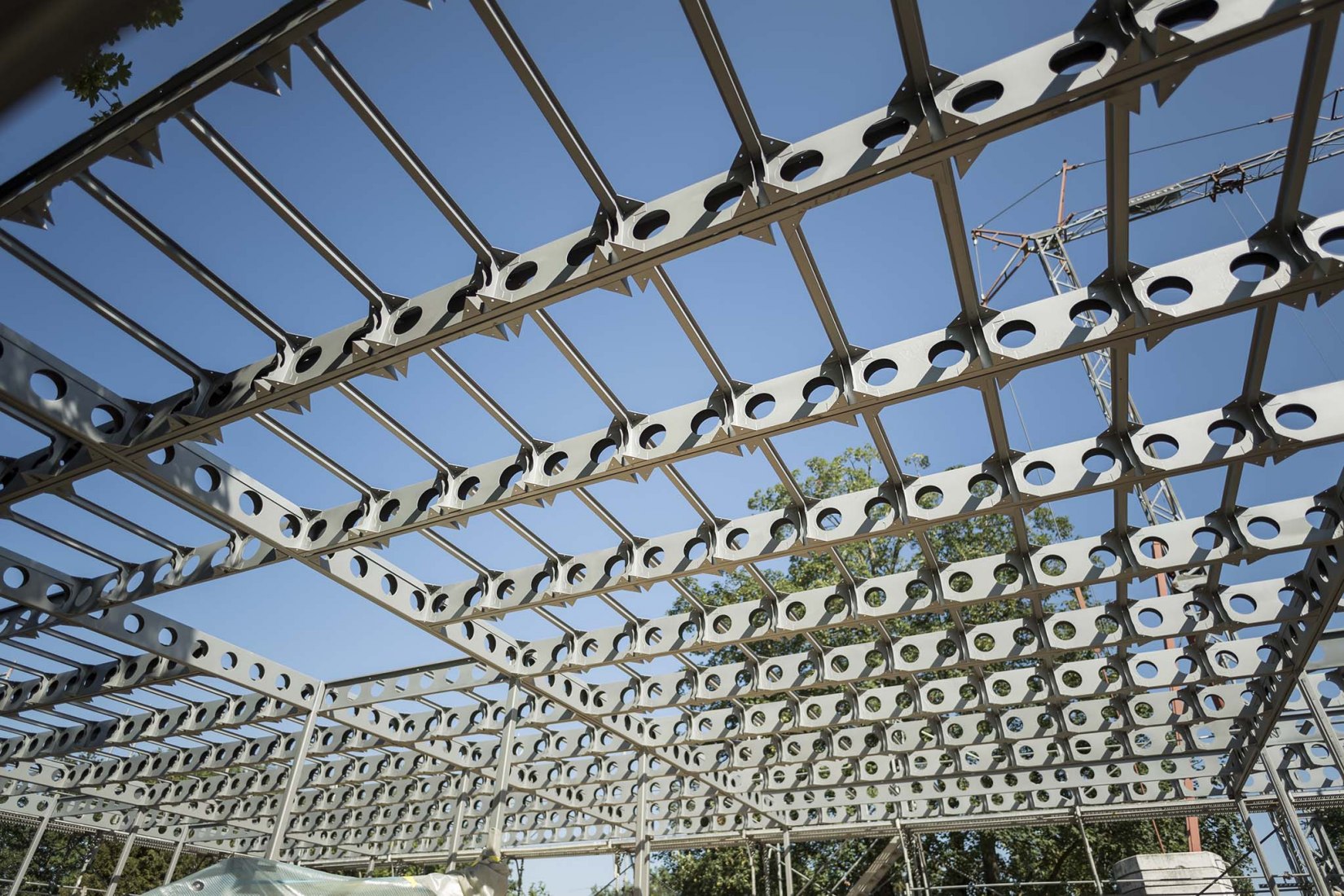Description of project by USM
A pioneering architectural work
The Buchli, overlooking the USM company's land, was the first residential project based on precast components. Designed by the famous Swiss architect Fritz Haller for the Schärer family in 1969, it was made with the USM Haller MINI steel construction system, which would serve as a prototype for future design applications. The smart design evokes what it means to live in a steel and glass structure with no clear separation between living and sleeping areas, with rooms without doors or windows that do not open. The Buchli House reflects the profound changes in architectural ideals of the post-war period.
The Mini, Midi, Maxi modular building systems, as well as the USM Haller furniture system derived from them, have carved a niche in the history of Swiss architecture and design. Fritz Haller and Paul Schärer jr. relied on systematic thinking, and so did Alexander, son, and successor of Paul Schärer. Over the past 20 years as CEO of the company, Alexander has expanded the business and sustained its success with a healthy combination of innovation and product optimization of proven quality.
USM's success is rooted in the visionary architectural concept of a home, the Buchli, which was painstakingly remodeled in 2019 to commemorate its 50th anniversary, preserving the same building principles and standards for monument preservation as the original.
The "Buchli": a house with a vision of the future Comprehensive renovation of the Schärer residence and its transformation into a guest house
Situated at the top of a slope above the USM company premises, overlooking the plain next to the Aare river and the Alps, a unique residence with enormous architectural and historical significance has been erected since 1969. The Schärer family, the founder of USM, recently decided to undertake a complete remodeling of what was once their private residence, maintaining the original constructive principles as well as the original aesthetics, and complying at all times with the rigorous conditions for the protection of heritage. The works have just finished converting the former residence of the Schärer into a guest house of the USM company.
The house, which soon received the nickname "Buchli" for the land on which it sits, was built in 1968 on behalf of the young director of USM, Paul Schärer. The building is the work of Fritz Haller (1924–2012), a pioneer of the modular building system and one of the most influential Swiss architects of the post-war period.
The meeting between the engineer Schärer and the architect and researcher Haller, in the sixties of the last century, marked a new chapter in the history of architecture and the Swiss design. As a result of this alliance, three steel construction systems emerged to create highly flexible industrial and commercial buildings, following the requirements of the era and based on the belief in progress and technology, which characterized the second half of the twentieth century. At that time, the world-famous USM Haller modular system was also born, which would become a design classic.
As a prototype of a new way of "Living with a system", the Schärer house was the first to incorporate the Haller MINI steel construction system. The novelty consisted of a metallic structure of modular components filled with glass, without the conventional divisions in living and sleeping areas, without rooms with doors, and without windows that could be opened. A distribution that could be modified at any time using the strict grid system with movable walls. While this may not seem too groundbreaking today, given today's wide variety of room and lifestyle configurations, the early 1970s was a true leap into the unknown.
The Schärer house illustrates the radical transformation of social and architectural ideas in the post-war period. Family life depicted on a 12 x raised platform 14.4 m with two front terraces, minimum sleeping spaces, and two small bathrooms. The space offered little privacy because it was open and transparent to the inside and outside.
After a meticulous comprehensive rehabilitation in which all the heritage protection requirements have been taken into account, this former residence will from now on serve as a guest house; temporary accommodation for USM corporate guests, and a complement to their hospitality concept.
In 2016 Atelier Oï transformed the mechanical workshop used by the first generation of the USM family business into the "Kochwerkstatt" (kitchen workshop). In it, Urs Hauri and Christian Thierstein delight guests, professionals, and individuals, with exquisite dishes made mainly with regional and seasonal ingredients, and cookery courses are offered. The workshop will also prepare refreshments for guests staying at the Buchli.
La Buchli: the key to USM's success
La Buchli, the private residence of the Schärer family, sits on top of a small hill overlooking the company site in Münsingen, offering lavish panoramic views. Baptized with the diminutive Buchli after the land where it sits, in 2019 a comprehensive remodeling was undertaken to commemorate its 50th anniversary. It was designed and built by Fritz Haller, one of the most influential Swiss architects of the 20th century. This pioneer of modular construction developed the three frame and installation systems MINI, MIDI, MAXI, based on the basic principle of steel construction. Haller and Paul Schärer jr. They applied this systematic approach to furniture design as well, which gave rise to the world-renowned USM Haller modular furniture system.
Mini, Midi, Maxi
In the 1960s, Fritz Haller christened his modular building systems MINI, MIDI, and MAXI: "mini" for private residences and offices, "midi" for vertical constructions such as schools, and "maxi" for industrial complexes. Paul Schärer jr., Father of current CEO Alexander Schärer, was enthusiastic about Haller's idea of modular architecture. Projects for a new manufacturing facility, an administrative building, and the family's private residence followed. The Buchli was built in 1969 using the Mini principle, intended for one- and two-story buildings. It consists of several groups of elements: support structure, flooring, roof, and exterior wall. The foundations, the basement, and the interior equipment are made to measure. The supporting structure of columns and beams can be extended horizontally in all directions. The elements of the enclosure are removable and can be interchanged within the modular arrangement. Among the indisputable advantages of this system are short construction times and easy conversion and expansion options.
The private residence
The Schärer house was Fritz Haller's first residential project based on precast components. It sits on a hillside overlooking the company's premises. From the rooms on the upper floor, you can enjoy a breathtaking panoramic view of the Aare river basin. The upper level of the house is accessed from the road, and from there to the covered parking located on the ground floor. The Buchli stands on a structure whose support points follow the rhythm of 2: 5: 2: 5: 2. The lobby, located on the central axis of the ground floor ends in a metallic spiral staircase that connects with the upper floor, raised on pillars. The basement houses an office and a guest room. On the upper floor, the central facility and circulation area border the kitchen and three northeast-facing bedrooms with en-suite bathrooms. The spacious open plan living/dining room with balcony extends to the southwest across the entire width of the building. The outer shaft also forms a balcony at the rear. The built-in cupboards and the central body of the kitchen was designed by Haller. The freestanding fireplace also fits into the grid, as does the rest of the interior furniture, for which the USM Haller modular system was used. The tall rectangular windows that are 1.20 meters wide add the finishing touch to this magnificent composition. In 2019, the costly comprehensive remodeling process began, maintaining the original construction principles and aesthetics, and complying at all times with the rigorous conditions for conservation of monuments. The Buchli residence is currently used as a guest house for the USM company. CEO Alexander Schärer, who belongs to the fourth generation of managers of the family business, grew up in this house and has many childhood memories associated with it.
USM Haller
Paul Schärer jun., Alexander's father, and Fritz Haller relied on systematic thinking. Once the construction projects were successfully executed, it only remained to find the right furniture for the open office on a single level. "After both tried various possibilities without success, they developed their modular furniture system - a universal solution," explains Alexander Schärer. These pieces of furniture, like the building, were not based on individual pieces, but on a system of adaptable steel modules that could be rearranged. In this way, the system could be adapted to the diverse needs of the production facilities and administrative buildings of the company. The USM Haller modular furniture system was born. Its combination of unique design, versatility, and durability was quick to capture public attention. USM Haller gained international renown thanks to a large commission, and the modular furniture system, originally intended for personal use, went into series production. Today, more than 50 years later, the demand for this versatile product remains high. Its furniture is used all over the world: often in offices, but increasingly in private residences. In the era of home offices, tasteful and functional furniture is increasingly important. "The timeless design and adaptability of the system have secured USM Haller a prominent position in the furniture market, and we expect the trend to continue for the next 50 years, "says Alexander Schärer looking to the future. USM Haller is one of the few furniture designs from the 1960s that remains unchanged today. functionality and precision, sobriety, and understated elegance, it has survived all fads. The modular furniture system has become an icon. It is simple, robust, flexible, and subtle in appearance. Its inclusion in the permanent collection of the Museum of Modern New York's Art (MoMA) catapulted USM Haller to the olympic of design. Durability has been a cornerstone of the USM company since its inception. The longer a product can be used, the lower its environmental impact. The use of materials Durable and high quality, manufactured using environmentally friendly methods, guarantees a long life cycle. "Our products last for decades and are much more environmentally friendly than products el made from natural materials such as wood, which consume a lot of energy during their manufacture and have a shorter half-life ", adds Alexander Schärer. This aspect is becoming increasingly important in ecological debates.
